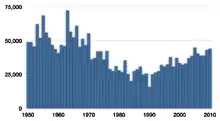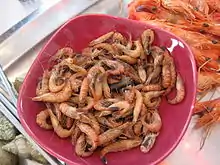Crangon crangon
Crangon crangon is a commercially important species of caridean shrimp fished mainly in the southern North Sea, although also found in the Irish Sea, Baltic Sea, Mediterranean Sea, and Black Sea, as well as off much of Scandinavia and parts of Morocco's Atlantic coast.[1] Its common names include brown shrimp, common shrimp, bay shrimp, and sand shrimp, while translation of its French name crevette grise (or its Dutch equivalent grijze garnaal) sometimes leads to the English version grey shrimp.
| Crangon crangon | |
|---|---|
 | |
| Scientific classification | |
| Kingdom: | Animalia |
| Phylum: | Arthropoda |
| Subphylum: | Crustacea |
| Class: | Malacostraca |
| Order: | Decapoda |
| Family: | Crangonidae |
| Genus: | Crangon |
| Species: | C. crangon |
| Binomial name | |
| Crangon crangon | |
| Synonyms [1] | |
Description
.jpg.webp)
Adults are typically 30–50 mm (1.2–2.0 in) long, although individuals up to 90 mm (3.5 in) have been recorded.[2] The animals have cryptic colouration, being a sandy brown colour, which can be changed to match the environment.[2] They live in shallow water, which can also be slightly brackish, and feed nocturnally.[2] During the day, they remain buried in the sand to escape predatory birds and fish, with only their antennae protruding.
Crangon is classified in the family Crangonidae, and shares the family's characteristic subchelate first pereiopods (where the movable finger closes onto a short projection, rather than a similarly sized fixed finger) and short rostrum.[3]
Distribution and ecology
C. crangon has a wide range, extending across the northeastern Atlantic Ocean from the White Sea in the north of Russia to the coast of Morocco, including the Baltic Sea, as well as occurring throughout the Mediterranean and Black Seas.[4] Despite its wide range, however, little gene flow occurs across certain natural barriers, such as the Strait of Gibraltar or the Bosphorus.[5] The populations in the western Mediterranean Sea are thought to be the oldest, with the species' spread across the north Atlantic thought to postdate the Pleistocene.[5]
Adults live epibenthically (on or near the sea-floor) especially in the shallow waters of estuaries or near the coast.[6] It is generally highly abundant, and has a significant effect on the ecosystems where it lives.[6]
Lifecycle
Females reach sexual maturity at a length around 22–43 mm (0.87–1.69 in), while males are mature at 30–45 mm (1.2–1.8 in).[7] The young hatch from their eggs into planktonic larvae. These pass through five moults before reaching the postlarval stage, when they settle to the sea-floor.[7]
Fishery

Historically, the commercial fishery was accomplished by horse drawn beam trawls on both sides of the Dover straits.[9] In the sandy shallows of Morecambe Bay (Lancashire, UK) horses have been replaced by tractors. Some small fishing vessels also use beam trawls for brown shrimp. A few artisanal fishermen use hand-pushed nets. In all UK shrimp fisheries, the catch is first 'riddled' to release the young of shrimps and fish. The shrimps are then traditionally boiled on board before landing.
Over 37,000 t of C. crangon were caught in 1999, with Germany and the Netherlands taking over 80% of this total.[1]
The UK lands an annual average of 1000 tonnes of brown shrimp, but the catch is highly variable between 1500 and 500 tonnes.[10] In the Lancashire fishery for brown shrimp it has been shown that landings in any year are related to the annual catch, average annual air temperature (inverse) and total rainfall in the previous year. That has enabled a good prediction of annual landings one year in advance.[11] Moreover, for the port of Lytham, the abundance of shrimp (annual catch per unit effort) was found to be closely correlated with the mean annual Zurich sunspot number for the period 1965-1975.[12] Given that sunspot numbers are predictable, this provides another tool for the prediction of annual shrimp catch. Sunspot cycle No. 23 (1997-2008) is a good example of the correlation between UK annual brown shrimp catch and mean annual sunspot number.[13]
As food

The brown shrimp enjoys great popularity in Belgium, the Netherlands, northern Germany, and Denmark.
Shrimp in general are known as garnalen in Dutch. It is the basis of the dish tomate-crevettes, where the shrimp are mixed with mayonnaise and served in a hollowed-out uncooked tomato. The shrimp croquette is another Belgian speciality; the shrimp are in the interior of the battered croquette along with béchamel sauce. Freshly cooked, unpeeled brown shrimp are often served as a snack accompanying beer, typically a sour ale or Flemish red such as Rodenbach.[14]
In Lancashire, England, the brown shrimp is mixed with butter and spices to make potted shrimps, a dish traditionally eaten with bread.[15]
References
- "Crangon crangon (Linnaeus, 1758)". Species Fact Sheets. Food and Agriculture Organization. Retrieved June 24, 2011.
- "Crangon crangon". ARKive. Archived from the original on 2008-05-17. Retrieved June 24, 2011.
- Joana Campos; Cláudia Moreira; Fabiana Freitas & Henk W. van der Veer (2012). "Short review of the eco-geography of Crangon". Journal of Crustacean Biology. 32 (2): 159–169. doi:10.1163/193724011X615569.
- Joana Campos; Vânia Freitas; Cindy Pedros; Rita Guillot & Henk W. van der Veer (2009). "Latitudinal variation in growth of Crangon crangon (L.): does counter-gradient growth compensation occur?". Journal of Sea Research. 62 (4): 229–237. Bibcode:2009JSR....62..229C. doi:10.1016/j.seares.2009.04.002.
- Pieternella C. Luttikhuizen; Joana Campos; Judith van Bleijswijk; Katja T.C.A. Peijnenburg & Henk W. van der Veer (2008). "Phylogeography of the common shrimp, Crangon crangon (L.) across its distribution range". Molecular Phylogenetics and Evolution. 46 (3): 1015–1030. doi:10.1016/j.ympev.2007.11.011. PMID 18207428.
- Joana Campos; Cindy Pedrosa; Joana Rodrigues; Sílvia Santos; Johanses I. J. Witte; Paulo Santos & Henk W. van der Veer (2009). "Population zoogeography of brown shrimp Crangon crangon along its distributional range based on morphometric characters". Journal of the Marine Biological Association of the United Kingdom. 89 (3): 499–507. doi:10.1017/S0025315408002312.
- Joana Campos & Henk W. van der Veer (2008). R. N. Gibson; R. J. A. Atkinson & J. D. M. Gordon (eds.). Autecology of Crangon crangon (L.) with an emphasis on latitudinal trends. Oceanography and Marine Biology: An Annual Review. 46. CRC Press. pp. 65–104. doi:10.1201/9781420065756.ch3. ISBN 978-1-4200-6575-6.
- Based on data sourced from the FishStat database, FAO.
- Charlier, Roger H (2012). "Crangon crangon, endangered or merely on a via dolorosa?" (PDF). Academy of Romanian Scientists Annals Series on Biology Sciences. 1 (1): 31–58. ISSN 2285-4177. Archived from the original (PDF) on 2015-04-02. Retrieved 2015-03-14.
- Catchpole, T. L., Revill, A. S., Innes, J., and Pascoe, S. 2008. Evaluating the efficacy of technical measures: a case study of selection device legislation in the UK Crangon crangon (brown shrimp) fishery. – ICES Journal of Marine Science, 65: 267–275.
- Driver, P. A. 1976. Prediction of fluctuations in the landings of Brown Shrimp (Crangon crangon) in the Lancashire and Western Sea Fisheries District. Estuarine and Coastal Marine Science (1976) 4, 567-573.
- Driver, P. A. 1978. The prediction of shrimp landings from sunspot activity, Marine Biology 47, 359-361
- Ibid 10
- "Les crevettes grises" (in French). Eating.be. Retrieved September 13, 2012.
- Paston-Williams, Sara (2005). "Morecambe Bay shrimps". Fish: Recipes from a Busy Island. London: National Trust. p. 140. ISBN 0-7078-0357-8.
External links
| Wikimedia Commons has media related to Crangon crangon. |
| Wikispecies has information related to Crangon crangon. |
- Joana Costa Vilhena de Bessa Campos (2009). The eco-geography of the brown shrimp Crangon crangon in Europe (Ph.D. thesis). Vrije Universiteit Amsterdam. ISBN 978-90-865-9350-7.
- Photos of Crangon crangon on Sealife Collection